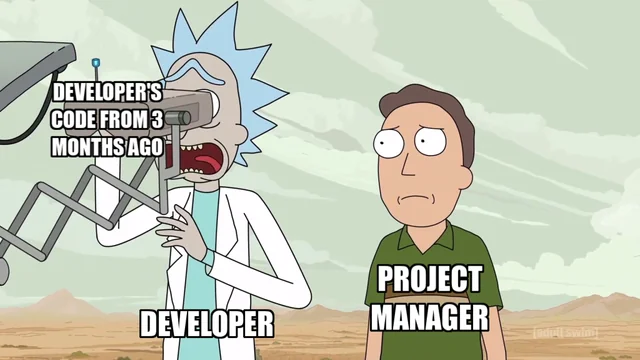What Is Technical Debt and Why It Matters to Your Business?
If you’ve ever worked on a digital product, you’ve probably heard someone mention technical debt. Maybe it came up during a stand-up, maybe someone dropped it casually in a PR review, or maybe you’ve felt it the hard way – trying to push a new feature live and realizing the codebase is fighting you back.
But what exactly is technical debt? And more importantly, why should you, as a product person, a founder, or anyone on the business side, actually care?
In simple terms, technical debt is the cost of choosing speed over quality in your code - shortcuts you take today that slow you down tomorrow. Just like financial debt, it can be strategic…but if you let it pile up, interest kicks in fast.
Understanding technical debt: why does it matter?
The term technical debt was coined by Ward Cunningham, one of the authors of the Agile Manifesto. It’s a metaphor: sometimes, you take a quick-and-dirty shortcut in your code so you can move fast now, but at some point, you’ll have to “pay it back” in the form of bugs, slower delivery, or painful refactors.
In other words: you ship fast today, but you make your life harder tomorrow.
This tecnhical debt can come from a bunch of places: rushed deadlines, legacy code, unclear product requirements, missing tests, or simply the fact that your product grew faster than your architecture. And to be fair - not all technical debt is bad.
Sometimes it’s strategic. But when it piles up and you ignore it? That’s when it becomes a real problem.
The hidden costs of technical debt
At first glance, technical debt might seem like an engineering issue. But it’s actually a business problem with real impact on your bottom line.
Here’s how it creeps into the core of your operations:
1️⃣ Slower time-to-market
As debt builds up, every new feature feels harder than it should. Developers aren’t just implementing something, they’re untangling past decisions, rewriting fragile logic, and second-guessing how things are wired together.
Example: Let’s say you want to roll out a new payment option. But the current system hardcodes payment logic into multiple services, without a clear abstraction layer. Instead of plugging in a new gateway in a day, you’re spending two weeks figuring out what breaks where. Meanwhile, your competitors are already live with it.
Missed opportunities, delayed releases, and frustration across the board.
2️⃣ Unexpected costs
Tech debt isn’t just annoying — it’s REALLY expensive. What should be simple fixes turn into rabbit holes, especially when there's no test coverage or clear architecture. Developers spend more time investigating than actually building.
Example: You want to localize your app for new markets. But all the UI text is hardcoded in components with no i18n system in place. Now, instead of just translating a few files, your team needs to refactor dozens of components and QA everything from scratch. What looked like a quick win becomes a budget drain.
And the worst part? Stakeholders don’t always see the complexity — they just see missed deadlines.
3️⃣ Buggy, unstable products
A codebase full of hidden assumptions, outdated logic, and inconsistent patterns leads to instability. Things that used to work start breaking as the system grows. And when bugs start affecting users, the cost is even higher — in support tickets, bad reviews, and lost trust.
Example: One of our clients had a checkout flow where promo codes were applied inconsistently. The logic was duplicated in frontend and backend, and changes in one part would break the other. Customers were getting incorrect discounts, or worse, seeing payment errors. That kind of instability is hard to recover from.
4️⃣ Team frustration and burnout
No one wants to work in a codebase that feels like a trap. When developers spend most of their time fixing edge cases, dealing with regressions, or navigating spaghetti logic, morale takes a hit. Over time, this leads to disengagement, poor collaboration, and eventually, team turnover.
Example: We’ve seen teams where onboarding new developers takes weeks just to understand how things are structured — because nothing is documented, everything is coupled, and there’s no clear pattern. Eventually, good developers leave not because of the product, but because the environment makes it impossible to do good work.
Replacing talent is expensive. Keeping them engaged is smarter.
5️⃣ Scaling becomes painful
As your user base grows, so does the load on your system — technically and operationally. If your architecture isn’t built to scale, every new spike in traffic, feature release, or data update becomes a gamble.
Example: We worked on a platform that stored all user data in a single, massive table — no indexing, no partitioning, no data model to speak of. It worked fine with a few hundred users. But when they started growing internationally, response times spiked, analytics failed, and downtime became a weekly issue. Retrofitting scalability into an already live product is 10x harder (and costlier) than doing it right from the start.

Why technical debt is inevitable - and that’s OK
Here’s the truth: you can’t avoid technical debt entirely. And that’s not necessarily a bad thing.
In fact, in many cases, technical debt is what allows you to move fast when speed matters most. Especially in early-stage products, shipping quickly and validating your assumptions is more valuable than building the most elegant architecture. Getting real feedback from users beats having “perfect code” no one’s using.
Just like financial debt, technical debt can be strategic. Startups, for example, often take on tech debt deliberately to validate their product, test the market, or hit a funding milestone. It’s a trade-off — and sometimes it’s the right one. But just like financial debt, it only works if there’s a plan to pay it back.
Where teams often go wrong is treating that early tech debt as a permanent solution. What worked at MVP stage might not hold up once you have thousands of users, new feature demands, and multiple developers working in parallel. If you don’t pause to refactor and stabilize the foundation, things start breaking in unpredictable ways.
It’s all about balance. You don’t need to build like a Fortune 500 company from day one. But you do need to evolve your codebase as your product and team grow.
How to manage technical debt like a pro
At Acid Tango, we work with startups and corporates alike to build digital products that don’t just work - they scale. And one of the most overlooked parts of that journey is how we handle technical debt.
Here’s our approach:
1. Make it visible
The first step to managing debt is acknowledging it. We treat tech debt like any other work — it gets written down, estimated, and added to the backlog. We tag it clearly in our boards and make sure it’s discussed during sprint planning.
We also flag areas in the design or code that we know need to change - using TODOs, inline comments, or external docs like TDLs - so we don’t lose track of them later.
If it’s not visible, it’s not actionable. And if it’s not actionable, it only gets worse.
2. Prioritize ruthlessly
Not all debt is equally painful. Some issues are annoying but harmless. Others are silent blockers that slow every release. We help teams weigh impact: is it breaking things, slowing development, confusing teammates, or blocking key features?
We use that to decide what’s worth fixing now vs. what can wait. It’s not about cleaning everything - it’s about cleaning the right things.
3. Refactor as you go
We’re big believers in micro-refactoring: improving the codebase every time you touch it, even if it’s just a rename or a small cleanup. Over time, those tiny improvements add up.
But when bigger changes are needed, we use strategies like the Strangler Pattern - gradually replacing legacy parts of the system with new, clean components without breaking everything at once. Instead of rewriting the entire app, we let the new grow around the old until it safely takes over. Martin Fowler has a great breakdown of it here.
We also use Anti-Corruption Layers (ACL) when integrating new systems with legacy code. These act as a translation layer, protecting your clean architecture from being “polluted” by outdated logic.
In short: we don’t wait for “tech debt weeks” or risky rewrites. We make quality part of the flow, not a separate event.
4. Align with business goals
Context matters. If you’re building a quick MVP to test an idea, some shortcuts are fine. But if you’re getting traction, raising investment, or hiring more devs — it’s time to get serious about stability.
We always ask: what does the business need from this product next? That tells us how much cleanup is worth doing now.
5. Invest in good practices early
It’s much easier to prevent tech debt than to dig your way out of it later. Things like clear architecture, code reviews, linters, CI pipelines, and tests might feel like overhead early on — but they’re actually safeguards.
They don’t slow you down. They keep you fast later when the pressure’s on.

What your company can do TODAY to start avoiding technical debt
Whether you're running a startup or leading digital transformation in a large organization, here's how to start taking technical debt seriously:
✅ Talk about it openly. Encourage your team to raise concerns without fear. Tech debt shouldn’t be a dirty word.
✅ Involve stakeholders. Business leaders should understand what tech debt is and how it affects performance, delivery, and cost.
✅ Allocate time and budget. Treat debt reduction like product development. It’s not optional if you want to build something that lasts.
✅ Work with the right partners. Choose a tech team—internal or external—that values long-term quality over short-term hacks.
Our perspective: what we think about it?
We believe that great products are built through smart trade-offs, but never at the cost of sustainability. Technical debt is part of the journey (but left unmanaged, it becomes a roadblock).
At Acid Tango, we help teams build digital products that aren’t just fast to market, but also built to last. Whether you're growing fast and want to clean up your architecture, or you're just starting out and want to avoid costly mistakes from day one, we can help.
We work side by side with teams to find the right trade-offs, clean up what matters, and keep products moving without losing sight of quality. If that’s something you’re thinking about - let’s talk. No pressure, no fluff. Just smart, sustainable product development.
